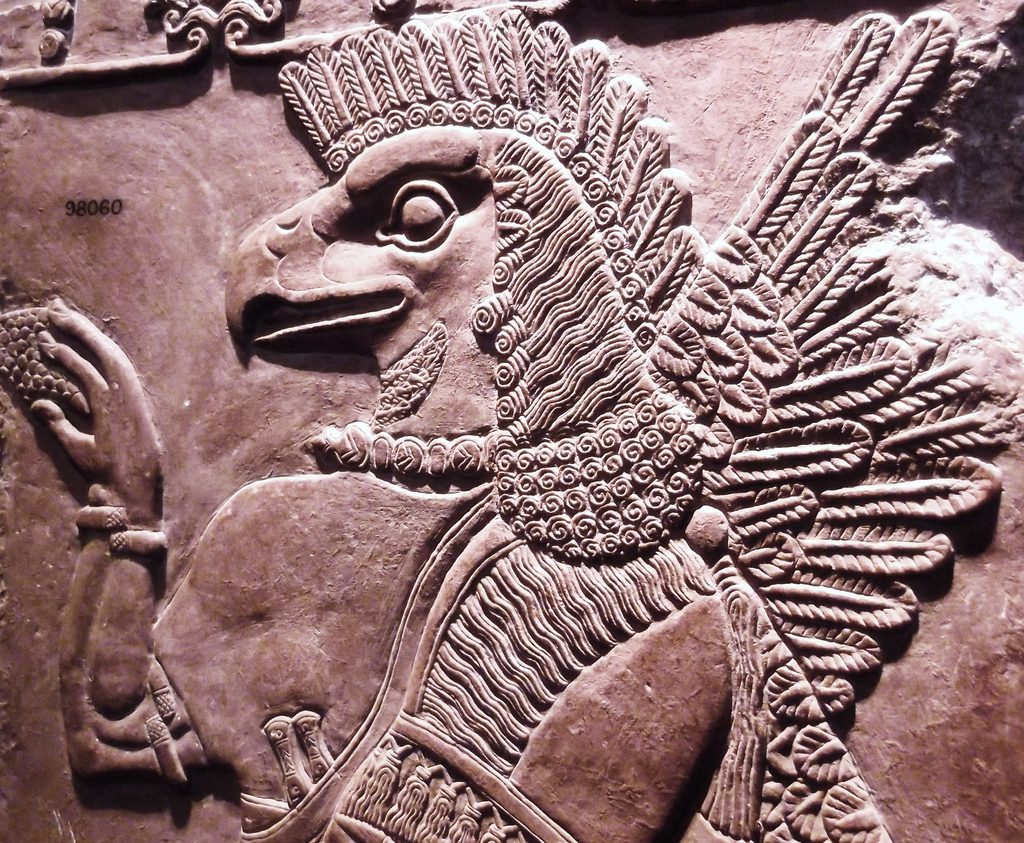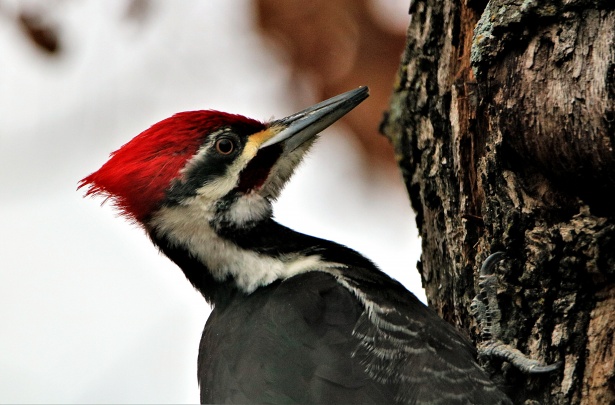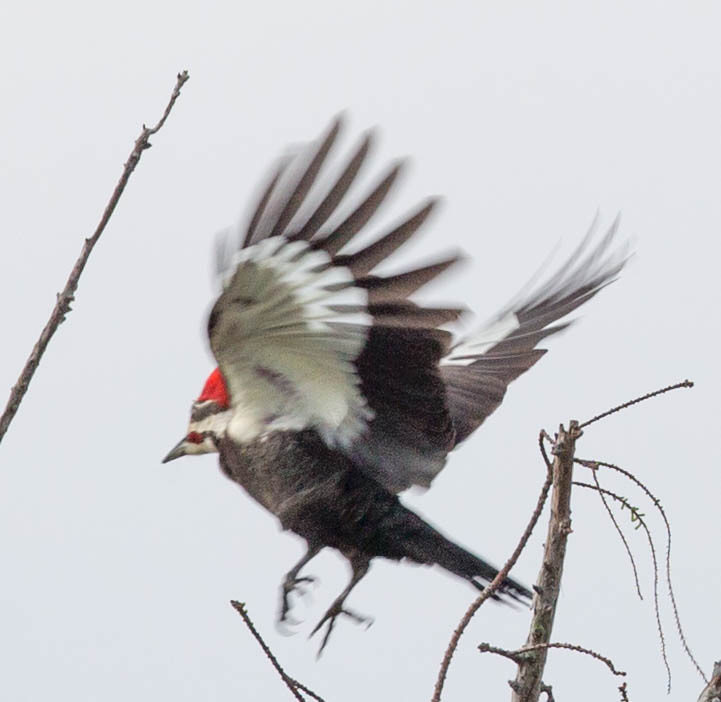The Pileated Woodpecker: Avian Divinity in a Time of Chaos

At one time, God was a bird. In ancient Egypt, Thoth was the Ibis-headed divinity of magic and wisdom. Winged divine beings – griffins and harpies – populated the pantheon of Greek antiquity, and Quetzalcoatl was the plumed serpent deity of the pre-Columbian Aztecs. As well, biblical religion includes portrayals of God as the beaked and feathered Holy Spirit who, alongside the Father and Son, is the winged God of historic Christian witness. Appearing as a dove at the time of Jesus’ baptism, the bird-God of the New Testament signals the deep grounding of biblical faith in the unity of all things: divine life and birdlife, divinity and animality, heaven and earth, spirit and flesh. This précis of divine avifauna in the world’s religions signals the continuity of biblical religion with the animistic beliefs of Indigenous communities. In animism, all things are alive with sacred personhood and worthy of human beings’ love and protection insofar as Spirit enfleshes itself in all things. In animism, all things are persons – we inhabit a world of bird people, tree people, river people, and human people – only some of whom are human. In my judgment, this is the worldview that is needed for our time. My suggestion, then, is that animism is both humankind’s primal orientation to reality and could be the baseline of our different attempts today to nurture communities of hope and resilience in an era of global dying.
This past Spring in the Crum Woods – on the western edge of the Delaware River Basin and just east of the city of Philadelphia and due south of the gas fields of the Marcellus Shale – I encountered a wide variety of birds in my morning walks. On one particular Spring morning, I came across a mallard duck, a flock of double-crested cormorants, one broad-winged hawk, a group of red-bellied woodpeckers, a gathering of white-throated sparrows, and a congregation of American robins, among other feathered visitors in the woods.
 Amidst this display of avian biodiversity, I became especially intrigued with the growth and the life-cycle of a pileated woodpecker family. The pileated woodpecker is a strikingly beautiful winged creature. It is a large bird, about the size of a crow, mostly jet-black with slashing white stripes and a bright red crest on top of its head. I first saw one of the mature woodpeckers hammering out a nest hole in a dead tree on the banks of the Crum Creek. It cut wood chips out of the tree and then flicked them away from the newly excavated cavity with relish abandon, many of them splashing into the creek below. I watched this bird and its companion often feeding below the nest – pileated woodpeckers like ants and termites – by banging repeatedly into nearby trees. is a loud, brash, in-your-face bird that lights up the forest with its soaring flight, screeching call, and head-bashing impact. After a couple of weeks of nest-building by the adults, wonderfully, two baby pileated woodpeckers appeared. They screeched and clattered around the nest just like the parents. Another two weeks passed, and the babies fledged – effortlessly, it seemed, as they took flight through the forest echoing their parents’ wild energy and noisy calls.
Amidst this display of avian biodiversity, I became especially intrigued with the growth and the life-cycle of a pileated woodpecker family. The pileated woodpecker is a strikingly beautiful winged creature. It is a large bird, about the size of a crow, mostly jet-black with slashing white stripes and a bright red crest on top of its head. I first saw one of the mature woodpeckers hammering out a nest hole in a dead tree on the banks of the Crum Creek. It cut wood chips out of the tree and then flicked them away from the newly excavated cavity with relish abandon, many of them splashing into the creek below. I watched this bird and its companion often feeding below the nest – pileated woodpeckers like ants and termites – by banging repeatedly into nearby trees. is a loud, brash, in-your-face bird that lights up the forest with its soaring flight, screeching call, and head-bashing impact. After a couple of weeks of nest-building by the adults, wonderfully, two baby pileated woodpeckers appeared. They screeched and clattered around the nest just like the parents. Another two weeks passed, and the babies fledged – effortlessly, it seemed, as they took flight through the forest echoing their parents’ wild energy and noisy calls.
But as inspiring as this tableau appeared to me, the question should be asked whether there was anything particularly spiritual about observing these birds’ activities. It was awe-inspiring to bear witness to the care and concern the adult woodpeckers showed their young. They built a nest cavity of perfect proportions, soaring through the forest and chopping into trees for grubs for their chicks, and then they would huddle with their hatchlings for feeding and nurture. But as impressive to me as were the woodpeckers’ rituals of hunting, gathering, and nest-building, one could query whether there was a distinctive religious dimension to all of this aerial activity.
Or to put it another way, Is God or Spirit in the face of the pileated woodpeckers I found overhead in the Crum Creek? In response, an historical note. In the past, the pileated woodpecker’s closest cousin was the ivorybill woodpecker. The two woodpeckers are almost indistinguishable, with the ivorybill being a bit larger than the pileated with an ivory-colored bill (so its name) as opposed to the pileated’s gray-and-whitish bill. But in spite of their almost identical appearance, the ivorybill is now considered a “ghost bird,” a bird that is most likely extinct, sadly, because its original pre-twentieth century habitat, the swampy primeval forests of the American Southeast, was largely cut down for timber production. However, its counterpart, the pileated woodpecker, is thriving in the ivorybill’s home range and beyond, in large part because of modern sustainable forestry practices, so much so that the pileated woodpecker now flourishes in a large woodland arc extending from the Eastern United States through Canada and into the Pacific Northwest, including Northern California.
 In the Crum Woods, I was spell-bound when the pileated woodpecker would leave the nest and soar through the trees, darkening the ground at my feet with its almost thirty-inch wingspan. Its head-banging sound would ricochet through the forest. Its flight through the leaves and sky overhead would root me in place, unbelieving that such a creature is still with us. Ornithologist Scott Weidensaul writes about the similar reactions local people have experienced over time when the ivorybill, in particular, and the pileated woodpecker as well have taken flight above their heads. Historically, this spectacle prompted observers to call these sensational creatures the “By-God, look at that bird” woodpeckers – or simply, in moments of gasping, exclamatory wonder, “the Lord God bird.” Weidensaul writes, “The names [country folk] used for the ivorybill reflected the dazzle of seeing one of these huge birds rowing through the light-splashed swamps on powerful wings. King of the Woodpeckers, they called it. King Woodchuck. Giant woodpecker. Log God. Like the smaller but similar pileated woodpecker, it was sometimes called the Lord God bird, or the By-God, because that’s what a breathless greenhorn said when he first saw one: By God, look at that bird.”
In the Crum Woods, I was spell-bound when the pileated woodpecker would leave the nest and soar through the trees, darkening the ground at my feet with its almost thirty-inch wingspan. Its head-banging sound would ricochet through the forest. Its flight through the leaves and sky overhead would root me in place, unbelieving that such a creature is still with us. Ornithologist Scott Weidensaul writes about the similar reactions local people have experienced over time when the ivorybill, in particular, and the pileated woodpecker as well have taken flight above their heads. Historically, this spectacle prompted observers to call these sensational creatures the “By-God, look at that bird” woodpeckers – or simply, in moments of gasping, exclamatory wonder, “the Lord God bird.” Weidensaul writes, “The names [country folk] used for the ivorybill reflected the dazzle of seeing one of these huge birds rowing through the light-splashed swamps on powerful wings. King of the Woodpeckers, they called it. King Woodchuck. Giant woodpecker. Log God. Like the smaller but similar pileated woodpecker, it was sometimes called the Lord God bird, or the By-God, because that’s what a breathless greenhorn said when he first saw one: By God, look at that bird.”
To be sure, such outbursts can be read simply as impulsive reactions to the sudden appearance of a large, multi-colored bird ripping apart old logs with its massive bill, or wildly flying and shrieking high above the forest floor, blotting out the sun’s light overhead. But could such outbursts at the sight of the ivorybill or pileated woodpecker also be read as a hint of something else? Is it possible such outbursts are a clue in our core psyches that we are aware of something awe-inspiring – even divine – at play in the enchanted forests that surround us? Could such outbursts signify a rumor within our deepest selves that we are being visited by powers greater than ourselves – powers that offer us meaning and courage in a world increasingly devoid of hope in the future wellbeing of the planet?
And so for me today, crying out “Lord God!” at the sight of a pileated woodpecker, as others did at the sight of an ivorybill or pileated in days gone by, is a shout-out to all of creation that here in this place and at this time I am encountering a visage of God that is not unlike, I suspect, the two-thousand-year-old reaction of Jesus’ onlookers to the beaked-and-feathered Spirit above them at the time of Jesus’ baptism in the Jordan Valley. This, then, is my heartfelt belief and my hope: catching a site of the Lord God bird in the Crum Woods is to catch a site of God flying and rustling in my midst. In my “Lord God!” exclamation, my hope is that God is still active and alive in the woodlands and fields and rivers within all of this beauteous creation. My hope is that the winged God at Jesus’ baptism is once more taking flight as the Lord God bird in the Crum Woods, the avian divinity of the forest, the pileated woodpecker, who again calls to me and to all of us to find grace and pursue justice in our place and in our time as well. Could this animist expectation in Spirit as enfleshing itself within everything that grows, walks, flies, and swims in and over the Earth be the basis of our attempts today to forge communities of hope and resilience in a time of mass death? In my own life, let it be so, as I wager everything on the integrity of this hope and this prayer.
This is an excerpt from the book by Mark Wallace, When God Was a Bird: Christianity, Animism, and the Re-Enchantment of the World. It has been modified by the author.


HOW BEAUTIFUL passages ..I REALLY HOPE EVERYONE READS THESE BOOKS AND LEARN AND DO SOMETHING ABOUT PRESERVING OUR FORESTS, OURS SPECIES, OUR WORLD, OUR UNIVERSE AND OUR HUMANITY AS WELL.